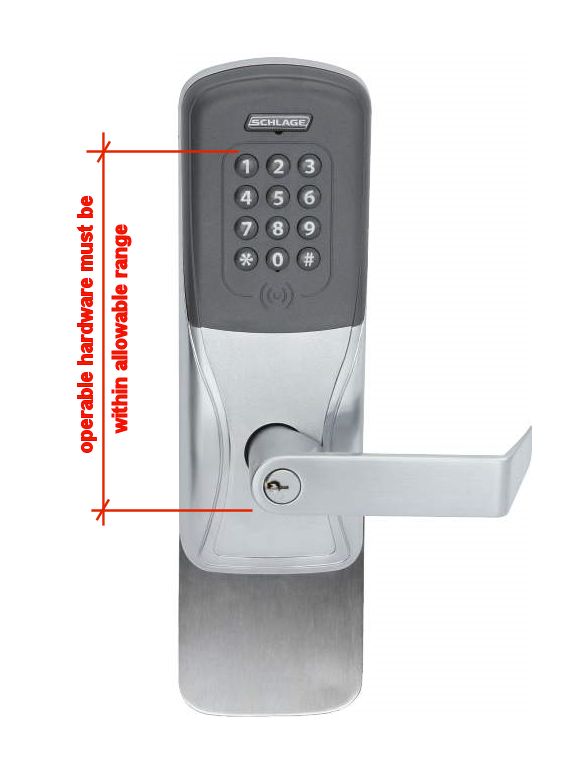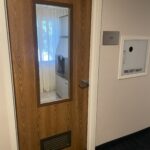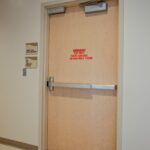 Just when I think I’ve run out of questions and potential pitfalls, one shows up in my inbox. A while back I wrote an article for Doors & Hardware, addressing the required mounting height for operable hardware. The model codes and accessibility standards require operable hardware to be mounted between 34 inches and 48 inches above the floor. I noted in the article that some states have adopted different requirements for hardware mounting heights.
Just when I think I’ve run out of questions and potential pitfalls, one shows up in my inbox. A while back I wrote an article for Doors & Hardware, addressing the required mounting height for operable hardware. The model codes and accessibility standards require operable hardware to be mounted between 34 inches and 48 inches above the floor. I noted in the article that some states have adopted different requirements for hardware mounting heights.
One of those states is California. Here’s the applicable section from the 2013 California Building Code:
11B-404.2.7 Door and gate hardware. Handles, pulls, latches, locks, and other operable parts on doors and gates shall comply with Section 11B-309.4. Operable parts of such hardware shall be 34 inches (864 mm) minimum and 44 inches (1118 mm) maximum above the finish floor or ground. Where sliding doors are in the fully open position, operating hardware shall be exposed and usable from both sides. (Refer to the code for exceptions addressing existing locks on certain types of doors, and operable hardware on pool gates.)
As you can see, California has reduced the acceptable range for operable hardware to between 34 inches and 44 inches, instead of 34 inches to 48 inches as required by the model codes and accessibility standards. The problem I ran into recently was with a keypad lock, where the lever was well within the 34- to 44-inch range specified in the California code, but the keypad buttons in the top row were above 44 inches. While the installation was compliant with the model codes because the keypad was below the 48-inch mark, the project was in California and the code official noted that the mounting height was not in compliance with the state code. A slight change in the mounting height would have ensured that both the lever and the buttons were within the allowable range, but that’s obviously a lot harder to address after the door and frame have been prepped.
Some may question whether the keypad is considered operable hardware, and whether it complies with the accessibility standards (the thought being that if it’s not accessible, it doesn’t matter if it’s not mounted in the allowable range). The standards are not specific about keypads, and although it may be difficult or impossible for someone with a disability to press the keys, technically keypads comply with the accessibility standards because they do not require tight grasping, tight pinching, or twisting of the wrist to operate.
I usually try to comply with the most stringent interpretation of the codes and standards in order to avoid problems – especially for issues that are not specifically addressed in the adopted publications. For a keypad lock, or other type of lock with operable components located one above the other, it’s important to ensure that all of these operable components will be located within the allowable range when the lock is installed. Check your local codes and standards to verify the allowable mounting height for operable hardware in your project’s jurisdiction.
You need to login or register to bookmark/favorite this content.





Simple solution: Don’t issue user codes using #S 1, 2, or 3.
For an existing installation that’s not a bad idea…it would be a reasonable accommodation to make an existing lock usable for someone with a disability. I don’t know if it will fly for the situation that’s currently being addressed – the locks are brand new.
– Lori
Unfortunately, as goes Cali so follows the rest of the nation. I wish that state would just fall into the ocean like it is supposed to do! Just kidding, but they do come up with some really stupid stuff, hence my statement.
44″ is the height because so many doors are FORWARD approach only (think of a typical hotel room where one has to pass between the closet and bathroom). Many other locations are similar. If only a forward approach is provided, then 44″ is the MAXIMUM height allowed (not just in CA).
And 42″ is an OK height as well.
Hi Liz –
Although the reach ranges may differ, the ADA standards and ICC A117.1 allow hardware to be mounted between 34 inches and 48 inches above the floor regardless of the approach. This is different from what is shown in the California accessibility standards.
– Lori
Thanks Lori! I brought this up in our weekly meeting and it was a real eye opener for most.
Great – glad I could help!
– Lori
What are the requirements for electrical receptacles, light switches, telephone and data outlets?
Hi Gerald –
I’m sorry, but I only deal with code requirements that apply to doors. I’m sure that what you’re looking for is in the National Electrical Code, but I don’t want to give you an incorrect answer.
– Lori
Thanks Lori. I’ll do the research.
If you have the electrician install upper outlets, switches roughed in between 40″- 42″ c.l. they should all comply (44″ forward approach, 48″ side approach, 46″ reach height over cabinetry). Too many #’s and none of them are installed correctly. If you can provide a dimension which they can hit with a laser level, the end results will be better.
For lower outlets, use 18″ o.c. aff. (15″ is the minimum height aff, but I had 1 job where the j-boxes were roughed in at 18″ aff, but the tile setters floated 2″ to set the tile! If they had been mounted at 16″ aff they would have been too low!).
T-stats: Usually the 40″-42″ aff is good, UNLESS the t-stat is a very long vertical model. It’s more critical to have the highest operable controls and screen at 44″ max. aff. But they can also be at 42″ and comply! Always check the model no.’s dimensions and mounting brackets relative to the j-box to figure out the exact height.
Lori,
I am a new locksmith and i heard of a situation in NYC about six years ago that there were some criminals i believe using a magnet to defeat a locking devise. I was wondering if you heard about this and if so if there is any reading material on this issue.
Thank in advance ,
Jim
P.S. Keep up the great work !!!!?
Hi Jim –
Were these hotel room locks?
– Lori
I am not sure with that. It very well could have been. I just heard a few people speaking about it and in conversation it was sid the manufacture had to redesign ssid lock.
Jim,
The lock was the old mechanical pushbutton type locks* and the issue was that by placing an “earth magnet” on one side, in just the right spot, the lock opened! The internal construction of the lock has sliding plates and the plates moved and bingo- you’re in! The locks have since been redesigned and the issue solved, at least on new product.
*(manufacturer’s name withheld for obvious reasons)
If I might add a few thoughts. If a mortise lock has both a cylinder and a Proximity reader, in this case the cylinder is within the 44″ range but the card reader (which does not require any pushing or touching) is beyond the 44″ or for that matter even 48″ is that a ADA issue? The idea is that the cylinder can be used as access or does the fact that the card reader is on the same door it stills requires the 44″ max.?
Normally, AHJs would require both the reader and the cylinder to be within the allowable range, except for locks operated only by security personnel.
– Lori